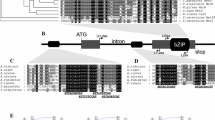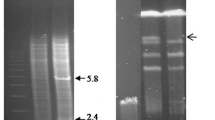Summary
Previous work (Rand and Arst, 1977) led to the proposal that the nis-5 mutation results in a new low activity promoter for niiA, the structural gene for nitrite reductase in Aspergillus nidulans. Expression of niiA via this promoter differs from expression of niiA via its normal promoter/initiator in that expression by the new promoter is not subject to nitrate induction or ammonium repression. nis-5 reduces but does not abolish niiA expression mediated by the normal promoter/initiator.
In this work we show that nis-5 is associated with and is probably identical to a non-reciprocal translocation in which a considerable portion of the centromere proximal region of the right arm of linkage group II is inserted into linkage group VIII between niiA and niaD, the tightly linked, probably contiguous structural genes for nitrate reductase. This implies that niiA, along with its normal promoter/initiator, has been fused to a promoter normally in linkage group IIR but as yet unidentified by its normal rôle. Further, it indicates that niiA is transcribed from the niaD-proximal side. As niiA and niaD are separated by a large number of unrelated genes in nis-5 strains, we can safely conclude that expression of niiA does not occur solely by synthesis of a messenger which carries a niaD as well as a niiA transcript. Clearly, niiA and niaD do not form an operon for which a di-(or poly-), cistronic messenger be the only transcript. This is consistent with other experimental evidence which shows that the synthesis of nitrate and nitrite reductases are not coordinately regulated. Nevertheless, all of these data would also be consistent with a model in which niiA and niaD form an operontype structure having overlapping transcripts, one being di-(or poly-) cistronic and including both niiA and niaD and another being monocistronic for niiA.
The reduced niiA expression mediated by the normal promoter/initiator in nis-5 strains could be a consequence of the functioning or positioning of the new linkage group II niiA promoter. An alternative, but not mutually exclusive, explanation would be that the insertional translocation prevents synthesis of a niiA niaD dicistronic transcript so that only that component of niiA expression which is due to a monocistronic niiA messenger can be induced by nitrate (and nitrite) in nis-5 strains. The apparently low activity of the new linkage group II promoter in comparison to the normal niiA promoter/initiator might betoken considerable efficiency of the latter rather than any particular lack of efficiency of the former.
In addition, this work has involved extensive new mapping in linkage group II, including both mitotic mapping of the centromere and meiotic mapping of previously unlocated markers. A series of crosses including genotype combinations both heterozygous and homozygous for nis-5 has been used to map the break-points and orientation of the translocation. As one break-point is closer to the centromere of linkage group II than the most centromere proximal identified gene on the same (i.e. right) arm we showed that the position of the centromere, as defined by mitotic recombination, has not been affected.
Similar content being viewed by others
References
Arst, H.N., Jr. Integrator gene in Aspergillus nidulans. Nature 262, 231–234 (1976)
Arst, H.N., Jr: Some genetical aspects of ornithine metabolism in Aspergillus nidulans. Mol. Gen. Genet. 151, 105–110 (1977)
Arst, H.N., Jr, Cove, D.J.: Nitrogen metabolite repression in Aspergillus nidulans. Mol. Gen. Genet. 126, 111–141 (1973)
Arst, H.N., Jr, MacDonald, D.W.: A gene cluster in Aspergillus nidulans with an internally located cis-acting regulatory region. Nature 254, 26–31 (1975)
Arst, H.N., Jr. MacDonald, D.W.: Reduced expression of a distal gene of the prn gene cluster in deletion mutants of Aspergillus nidulans: genetic evidence for a dicistronic messenger in an eukaryote. Mol. Gen. Genet. 163, 17–22 (1978)
Arst, H.N., Jr. MacDonald, D.W., Cove, D.J.: Molybdate metabolism in Aspergillus nidulans. I. Mutations affecting nitrate reductase and/or xanthine dehydrogenase. Mol. Gen. Genet. 108, 129–145 (1970)
Arst, H.N. Jr., Penfold, H.A., Bailey, C.R.: Lactam utilisation in Aspergillus nidulans: evidence for a fourth gene under the control of the integrator gene intA. Mol. Gen. Genet. 166, 321–327 (1978)
Barry, E.G.: Meiotic chromosome behavior of an inverted insertional translocation in Neurospora. Genetics 71, 53–62 (1972)
Boothroyd, E.R.: A light-microscopic study of some translocations in Aspergillus nidulans. can. J. Genet. Cytol. 20, 325–328 (1978)
Clutterbuck, A.J.: Mitotic recombination in linkage group II of A. nidulans. Aspergillus. New Letter 11, 2–3 (1970a)
Clutterbuck, A.J.: A variegated position effect in Aspergillus nidulans. Genet. Res. 16, 303–316 (1970b)
Clutterbuck, A.J.: Aspergillus nidulans. In: Handbook of genetics (R.C. King ed.) Vol. 1. pp. 447–510. New York: Plenum Press 1974
Clutterbuck, A.J., Cove, D.J.: The genetic loci of Aspergillus nidulans. In: CRC handbook of microbiology (A.I. Laskin and H. Lechevalier, eds.), 2nd ed., Vol. II. West Palm Beach, Florida: Chemical Rubber Co., in the press
Cove, D.J.: The induction and repression of nitrate reductase in the fungus Aspergillus nidulans. Biochim. Biophys. Acta 113, 51–56 (1966)
Cove, D.J.: Evidence for a near limiting intracellular concentration of a regulator substance. Nature 224, 272–273 (1969)
Cove, D.J.: Control of gene action in Aspergillus nidulans. Proc. R. Soc. Lond. [Biol.] 176, 267–275 (1970)
Cove, D.J.: Chlorate toxicity in Aspergillus nidulans. Studies of mutants altered in nitrate assimilation. Mol. Gen. Genet. 146, 147–159 (1976a)
Cove, D.J.: Chlorate toxicity in Aspergillus nidulans: the selection and characterisation of chlorate resistant mutants. Heredity (Lond.) 36, 191–203 (1976b)
Cove, D.J.: The genetics of Aspergillus nidulans. In: Genetics and physiology of Aspergillus (J.E. Smith and J.A. Pateman, eds.), pp. 81–95. London: Academic Press 1977
Cove, D.J., Pateman, J.A.: Autoregulation of the synthesis of nitrate reductase in Aspergillus nidulans. J. Bacteriol. 97, 1374–1378 (1969)
Dantzig, A.H., Zurowski, W.K., Ball, J.M., Nason, A.: Induction and repression of nitrate reductase in Neurospora crassa. J. Bacteriol. 133, 671–679 (1978)
Dorn, G.: Genetic analysis of the phosphatases in Aspergillus nidulans. Genet. Res. 6, 13–26 (1965)
Downie, J.A., Stewart, J.W., Brockman, N., Schweingruber, A.M., Sherman, F.: Structural gene for yeast iso-2-cytochrome c. J. Mol. Biol. 113, 369–384 (1977)
Downie, J.A., Stewart, J.W., Sherman, F.: Yeast mutants defective in iso-2-cytochrome c.. J. Mol. Biol. 117, 369–386 (1977)
Edwards, G.F.St.L., Normansell, I.D., Holt, G.: Benlate-induced haploidisation in diploid strains of Aspergillus nidulans and Penicillium chrysogenum. Aspergillus New Letter 12, 15 (1975)
Hastie, A.C.: Benlate-induced instability of Aspergillus diploids. Nature 226, 771 (1970)
Hynes, M.J., Kelly, J.M.: Pleiotropic mutants of Aspergillus nidulans altered in carbon metabolism. Mol. Gen. Genet. 150, 193–204 (1977)
Käfer, E.: Translocations in stock strains of Aspergillus nidulans. Genetica 33, 59–68 (1962)
Käfer, E.: Origins of translocations in Aspergillus nidulans. Genetics 52, 217–232 (1965)
Käfer, E.: Meiotic and mitotic recombination in Aspergillus and its chromosomal aberrations. Adv. Genet. 19, 33–131 (1977)
McCully, K.S., Forbes, E. The use of p-fluorophenylalanine with ‘master strains’ of Aspergillus nidulans for assigning genes to linkage groups. Genet. Res. 6, 352–359 (1965)
Mackintosh, M.E., Pritchard, R.H.: The production and replica plating of microcolonies of Aspergillus nidulans. Genet. Res. 4, 320–322 (1963)
Mather, K.: Crossing-over. Biol. Rev. 13, 252–292 (1938)
Mather, K.: Crossing-over and heterochromatin in the X chromosome of Drosophila melanogaster. Genetics 24, 413–435 (1939)
Morris, N.R.: Mitotic mutants of Aspergillus nidulans. Genet. Res.. 26, 237–254 (1975)
Pateman, J.A., Cove, D.J.: Regulation of nitrate reduction in Aspergillus nidulans. Nature 215, 1234–1237 (1967)
Pateman, J.A., Rever, B.M., Cove, D.J.: Genetic and biochemical studies of nitrate reduction in Aspergillus nidulans. Biochem. J. 104, 103–111 (1967)
Perkins, D.D., Barry, E.G.: The cytogenetics of Neurospora. Adv. Genet. 19, 133–285 (1977)
Pontecorvo, G., Käfer, E.: Genetic analysis based on mitotic recombination. Adv. Genet. 9, 71–104 (1958)
Pontecorvo, G., Roper, J.A., Hemmons, L.M., Macdonald, K.D., Bufton, A.W.J.: The genetics of Aspergillus nidulans. Adv. Genet. 5, 141–238 (1953)
Rand, K.N., Arst, H.N., Jr. A mutation in Aspergillus nidulans which affects the regulation of nitrite reductase and is tightly linked to its structural gene. Mol. Gen. Genet. 155 67–75 (1977)
Rand, K.N., Arst, H.N., Jr.: Mutations in nirA gene of Aspergillus nidulans and nitrogen metabolism. Nature 272, 732–734 (1978)
Rever, B.M.: Biochemical and genetical studies of inorganic nitrogen metabolism in Aspergillus nidulans. Ph.D. Thesis, University of Cambridge (1965)
Scazzocchio, C.: Studies on the genetic control of purine oxidation in Aspergillus nidulans. Ph.D. Thesis, University of Cambridge. (1966)
Sherman, F., Helms, C.: A chromosomal translocation causing overproduction of iso-2-cytochrome c in yeast. Genetics 88, 689–727 (1978)
Sherman, F., Stewart, J.W., Helms, C., Downie, J.A.: Chromosome mapping of the CYC7 gene determining yeast iso-2-cytochrome c: structural and regulatory regions. Proc. Natl. Acad. Sci. U.S.A. 75, 1437–1441, (1978)
Sorger, G.J., Debanne, M.T., Davies, J.: Effect of nitrate on the synthesis and decay of nitrate reductase of Neurospora. Biochem. J. 140, 395–403 (1974)
Tomsett, A.B.: Structure and function in the niiA niaD gene region of Aspergillus nidulans. Ph.D. Thesis, University of Cambridge (1977)
Upshall, A., Giddings, B., Mortimore, I.D.: The use of benlate for distinguishing between haploid and diploid strains of Aspergillus nidulans and Aspergillus terreus. J. Gen. Microbiol. 100, 413–418 (1977)
Author information
Authors and Affiliations
Additional information
Communicated by W. Gajewski
Rights and permissions
About this article
Cite this article
Arst, H.N., Rand, K.N. & Bailey, C.R. Do the tightly linked structural genes for nitrate and nitrite reductases in Aspergillus nidulans form an operon? Evidence from an insertional translocation which separates them. Molec. Gen. Genet. 174, 89–100 (1979). https://doi.org/10.1007/BF00433309
Received:
Issue Date:
DOI: https://doi.org/10.1007/BF00433309




